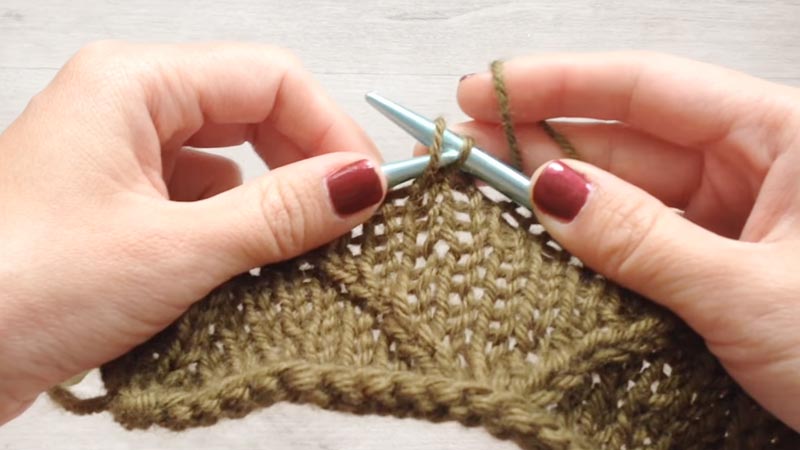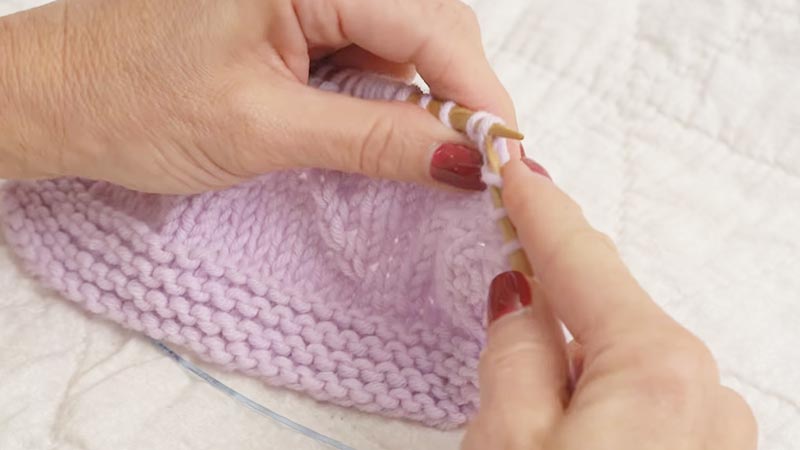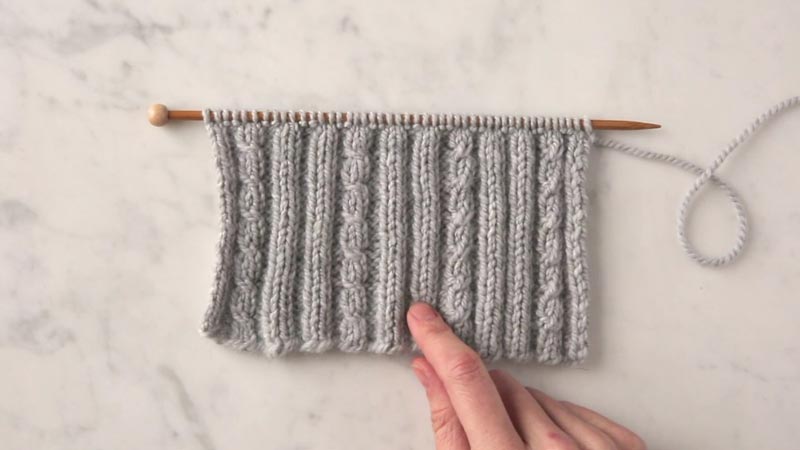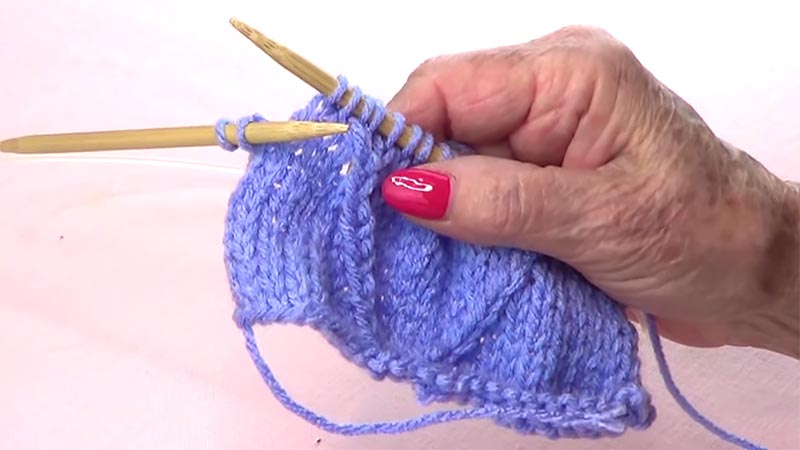A Left Twist in knitting, often referred to as an “LT” or “Mock Cable Stitch,” is a captivating technique that elevates the art of knitting. This method enables crafters to infuse their creations with texture, depth, and an eye-catching design element.
Crossing one stitch over another produces a left-leaning twisted effect within the fabric. What makes the Left Twist especially appealing is its ability to mimic the intricate look of traditional cables without the need for a cable needle, simplifying the process while maintaining the visual allure.
Whether you’re a seasoned knitter looking to diversify your projects or a novice seeking to add a touch of sophistication, the Left Twist is a versatile and creative addition to your knitting repertoire.

What Is A Left Twist In Knitting?
A Left Twist in knitting, also known as an “LT” or a “Mock Cable Stitch,” is a technique that creates a twisted effect in the fabric. It involves crossing one stitch over another to form a left-leaning twist.
To create a Left Twist, insert your needle into the second stitch, knit through the back loop, then knit the first stitch before sliding both off. This stitch adds texture and decorative detail to knitting projects, mimicking the look of traditional cables without requiring a cable needle.
Left Twists can be integrated into various stitch patterns, making them a versatile choice for enhancing the visual appeal and complexity of your knitting.
How Do You Make a Left Twist in Knitting?

Making a Left Twist in knitting involves several steps that result in a distinctive left-leaning twist within your fabric. This technique adds texture and visual interest to your knitting projects.
Here’s a breakdown of how to create a Left Twist:
Prepare Your Yarn
The process begins by ensuring your working yarn is correctly positioned at the back of your knitting work. This initial setup is essential as it sets the stage for the subsequent actions.
Insert Your Needle
With your yarn ready, gently insert your right knitting needle into the second stitch on the left needle. It’s crucial to go from right to left, entering through the back loop of the stitch. This specific insertion technique is fundamental to achieving the left-leaning twist.
Knit Through the Back Loop
Once your right needle is appropriately positioned in the back loop of the second stitch, knit through that back loop. However, be cautious not to let the stitch slip off the left needle at this point.
Knit the First Stitch
After knitting through the back loop, proceed to insert your right needle into the first stitch on the left needle, treating it as if you were going to knit it in a regular manner.
Complete the First Stitch
Execute a standard knit stitch on the first stitch, ensuring that it’s securely knitted.
Slide Both Stitches Off
In the final step, gently slide both the first and second stitches off the left needle simultaneously. This crucial act firmly secures the Left Twist, leaving you with a left-leaning twisted stitch.
What Are the Uses of Left Twist Stitches in Knitting Projects?

Left Twist stitches, also known as “LT” or “Mock Cable Stitch,” serve several valuable purposes in knitting projects. These versatile stitches add texture, visual interest, and decorative elements to your work, making them a popular choice for knitters.
Here are some of the key uses of left-twist stitches in knitting projects:
Texture and Depth
Left Twist stitches introduce a textured, three-dimensional quality to your knitting. The twisted effect creates raised, visually appealing patterns on the fabric, making it more interesting and tactile.
Decorative Accents
Left Twist stitches can function as decorative elements in your knitting. Their unique left-leaning twist adds a distinctive touch to your work, making it stand out from plain knits and purls.
Mimicking Cables
Left Twist stitches provide the appearance of traditional cables without the complexity of using a cable needle. This makes them an excellent choice when you want to achieve the aesthetic of cables in a simpler way.
Ribbing and Borders
Left Twist stitches can be seamlessly incorporated into ribbing patterns or used to create attractive borders on your knitting projects. They enhance the overall look of your work, making it more visually appealing.
Combining with Other Stitches
Left Twist stitches can be combined with various other stitch patterns, such as knit and purl stitches. This versatility allows you to create intricate and engaging textures, making them a great choice for more complex designs.
Structural Support
Beyond their decorative role, Left Twist stitches can serve to enhance the structural integrity of your knitting. They can be strategically placed to reinforce specific areas of your project, adding strength and stability.
Visual Interest
Left Twist stitches add visual interest to your knitting projects, no matter if you’re creating garments, scarves, blankets, or accessories. Their adaptability means you can incorporate them into various patterns, enhancing the overall appeal of your work.
How Can Left Twist Stitches Be Integrated Into Different Knitting Patterns?

Integrating Left Twist stitches into different knitting patterns allows you to add texture and visual interest to your projects.
Here are some ways you can incorporate Left Twist stitches into various patterns:
Ribbing
Left Twist stitches can be used to create textured ribbing. For example, in a 2×2 rib pattern, you can replace some of the standard knit or purl stitches with Left Twist stitches to add a twisty, ribbed effect.
Seed Stitch
In a seed stitch pattern, alternate Left Twist stitches with purl stitches to create a visually intriguing texture. This can add depth and complexity to your fabric.
Cable Patterns
Left Twist stitches can be integrated into traditional cable patterns. Use them in place of or in combination with cable stitches to create unique cable designs that lean to the left.
Basketweave
Combine Left Twist stitches with knit and purl stitches to form a basketweave pattern. The twisted stitches can add a distinctive look to the “woven” sections.
Lace Patterns
Incorporate left-twist stitches into lace patterns to create an unusual and eye-catching texture within lacework. These stitches can serve as decorative elements in lace designs.
Garter Stitch Borders
Add Left Twist stitches to the borders of garter stitch sections in your project. This will create a decorative edge and enhance the overall appearance.
Textured Panels
Create textured panels within your project by alternating left-twist stitches with other stitch patterns, such as cables or lace. This can break up the monotony of a larger piece and draw attention to certain sections.
Allover Texture
Use Left Twist stitches as an allover texture within a project. This is particularly effective in projects like scarves, where the texture can be showcased prominently.
Seamless Transitions
Blend Left Twist stitches seamlessly with other stitch patterns. Gradually introduce them within a project to create a smooth transition and maintain a cohesive look.
Custom Designs
Experiment with Left Twist stitches to design your unique patterns. Combine them with other stitches, vary the spacing, or use them as shaping elements to create one-of-a-kind pieces.
FAQs
What tools are needed to create a Left Twist in knitting, and is it suitable for beginners?
To make a Left Twist, you’ll need knitting needles and yarn. While it may seem complex, with practice, beginners can master this technique to add flair to their knitting projects.
Are there alternative names for Left Twist in knitting?
Yes, Left Twist is sometimes referred to as “LT” or “Mock Cable Stitch” due to its resemblance to traditional cable knitting.
How is a Left Twist stitch different from a traditional cable stitch?
A Left Twist mimics the appearance of traditional cables without the need for a cable needle, simplifying the process while achieving a similar look.
Are Left Twist stitches suitable for both knit and purl stitch patterns?
Yes, Left Twist stitches can be incorporated into both knit and purl stitch patterns, offering versatility in design.
How can I fix a mistake in a Left Twist stitch if I drop a stitch or make an error?
To fix a mistake in a Left Twist stitch, carefully un-knit to the error point, then rework the stitch following the correct sequence.
To Recap
The Left Twist in knitting is a versatile and artistic technique that transforms ordinary knitted fabric into something extraordinary. With its ability to add texture, depth, and visual intrigue, Left Twist stitches enhance the aesthetic appeal of various knitting projects.
Whether used for decorative elements, mimicking cables, or combining with other stitches to create complex textures, they provide endless creative possibilities for crafters of all skill levels.
The Left Twist’s simplicity, combined with its power to create the illusion of traditional cables without the cable needle, makes it an attractive choice for those seeking to elevate their knitting creations.
By mastering the Left Twist, knitters unlock a world of design potential, where each stitch becomes a work of art.
Leave a Reply